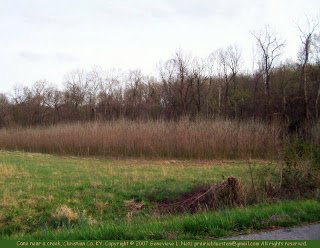Cane still grows in Christian County, Kentucky
I read about canebrakes for years before I came to Kentucky. Usually, frontiersmen were clambering through dense canebrakes, or Indians were hiding in canebrakes waiting to attack. The cane was said to clatter as horsemen passed through.
After I had lived in Kentucky for a few years, I realized that I was in the land of canebrakes but I hadn't seen any yet. I asked a few questions. The neighbors laughed at me. "Cane? What do you want cane for? Well, it's everywhere. Just look around."
Eventually, I took a good look at some tall, coarse vegetation growing in a road ditch in our neighborhood and I realized that it had to be cane. Then, when I knew what it looked like, I began to see many small patches of cane in swampy areas and on the moist banks of waterways.
Huge canebrakes in Kentucky history
A few centuries ago, the southeastern United States contained hundreds of thousands of acres of canebrakes. On river banks, cane grew in stands as large as "several hundred yards wide and several miles long". James O'Luken writes in The Kentucky Encyclopedia that some canebrakes covered "hundreds of acres". An article in Restoration Ecology quotes a description of a Kentucky canebrake in 1790 that was "15 miles [24 km] long and nearly half as wide".
When the winter is not too cold, the cane plant stays green. It was (and is) a nutritious food for the large herbivores and omnivores of Kentucky. The canebrakes also provided food and habitat for many smaller animals, including the now-rare swamp rabbit.
When settlers came to Kentucky, they knew that cane grew in the richest soil of the river bottoms. The fertility of the soil made the hard work of clearing the cane brakes worthwhile. Cane spreads underground through rhizomes. A long-established cane brake would have had an incredibly tangled mass of thick roots, making it very difficult to break the ground with a plow. The battle with sprouts would have been ongoing.
Two native cane subspecies
Arundinaria gigantea, the native cane of Kentucky and the southeastern U.S., is a member of the bamboo family. There are two varieties of native cane -- giant cane (Arundinaria gigantea ssp. gigantea) and arrow cane (Arundinaria gigantea ssp. tecta). Both types are sometimes called "river cane".
Giant cane grows as tall as 30 feet. It is said to prefer the floodplains. The cane around my neighborhood may be arrow cane (also known as switch cane) which is said to grow in upland situations. I don't think I've seen any cane taller than 15 feet in this area, and most of it is shorter than that.
Giant cane and arrow cane are so similar in appearance that it's difficult even for botanists to tell them apart. They can be identified by their blossoms, but canebrakes go as long as fifty years before flowering.
The photo above was taken in early spring after a cold winter. The leaves on the stalks were frozen back during several spells of sub-zero weather. This patch of cane grows near a small creek in a neighbor's field. Some good, close-up photos of native cane can be viewed at The Browyers Den.
Read more on the Internet:
River Cane
Encyclopedia of Alabama: Canebrakes
Canebrakes in old-time Georgia

3 comments:
Does Kentucky have road ditches? Iowa was largely marshland before the road ditches drained it. I imagine there would have been bigger canebrakes and cattail clumps in un-drained land.
That's an interesting thought. Kentucky does have ditches along the roads, and some ditches (like the one that runs past our mailbox), are actually waterways. Down the road from us, the ditch water runs out into a pasture as a little creek, joins up with another little creek, and becomes part of the river in another mile or so.
I haven't traveled Iowa much for years, but my memories are that Iowa has a gridwork of rural roads that run mostly along the edges of section lines. Here -- and in most of Kentucky, I believe -- the rural roads rarely follow a straight line for a mile. They follow the old trails that sought the easiest path through the obstacles -- which is probably more or less the same path that water would take.
When Iowans talk about preserving the state's ecology and environment, most of them don't realize that most of it was already 'destroyed' by drastic drainage schemes.
Post a Comment